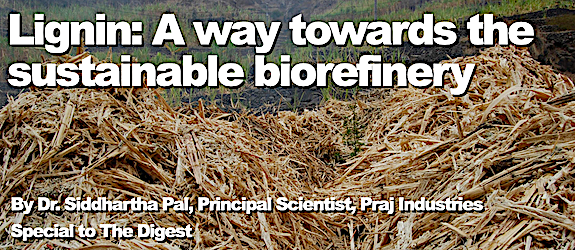Lignin: A way towards the sustainable biorefinery

By Dr. Siddhartha Pal, Principal Scientist, Praj Industries
Special to The Digest
Various sources of lignocellulosic biomass, such as forestry waste and agricultural feedstocks, are available all over the world. The Lignocellulosic biomass consists of three major components: cellulose, hemicellulose, and lignin. Cellulose and hemicellulose form a network in which lignin acts as a glue making the cell wall recalcitrant.
One of the most abundant polymers in nature, lignin contains a lot of aromatic compounds. It is generally considered as an underutilized side-stream from pulp and paper or second-generation ethanol plants and majorly being used widely as a source of energy for the boiler. However, with the technology advances, it is increasingly recognized as essential feedstocks for the quickly expanding bioeconomy.
Lignin structure
Due to its versatile properties’, lignin derivatives have found diverse industrial applications ranging from fuel to biomaterials. The valorization of lignin into valuable products is a way of unleashing its potential.
For the commercial feasibility of the biorefinery complex and the growing environmental issues associated with the use of fossil fuels, there is a persistent surge in interest in producing high value-added products from lignin. However, there are three significant obstacles that must be overcome first: analytics, processing, and product application. This might facilitate the customization of lignin and its value-added by-products for the upcoming fuels and materials applications.
Lignin processing
Lignin is extracted from biomass through various processes and then purified or functionalized to make different products out of it. Most commonly used methods for lignin processing are as follows:
– Alkaline extraction: It is the major process used in chemical pulping, accounting more than 80% of the total lignin production in the world. The process is performed at a high pH (12-14) and about 90% of the lignin is dissolved into the black liquor.
– Organosolv process: It constitutes the fractionation of biomass using an organic solvent, such as ethanol, acetone, tetrahydrofuran, and γ-valerolactone etc.
– Also, ionic liquids (ILs) and deep eutectic solvents (DESs) are promising agents for lignin fractionation due to their high solvation in the dissolution of lignin.
Lignosulfonates and Bio Bitumen: Decarbonizing the Construction Industry
The construction sector accounts for approximately 25% of global CO2 emissions worldwide. Lignin and its derivatives are used as cement additives at ready-mix concrete plants to improve cement workability and as a partially bitumen replacement in the production of asphalt.
Praj is working on developing a strategy in which the lignin, a co-product of the second-generation ethanol bio refinery, is being valorized to obtain value added products. As a result, the bio refinery model becomes more sustainable and commercially viable.
Up to this point, Praj Industries has developed the technology to produce the following two products from crude lignin:
Lignosulfonates: It is a sustainable bio-admixture for concrete used as a plasticizer or retarder to majorly improve workability. The lignosulfonate samples made from sugarcane bagasse and rice straw were examined by a global company involved in the ready-mix concrete sector. They conducted the trails with various dosages of lignosulfonate in the ready-mix concrete. Numerous rheological and physico-chemical properties were investigated, and the findings were excellent.
The lignin co-product (residue of bioethanol process) undergoes sulfonation under alkaline conditions and controlled conditions of temperature, pH and reaction time to convert them into Lignosulfonates, which is a water-soluble anionic polyelectrolyte.
Bio Bitumen: In the flexible pavement industry, a part of the Bitumen is replaced with Bio Bitumen (modified lignin). Use of bio-bitumen specific to bitumen industry holds great promise as it can help,
(a) Sustainability and environmental problem
(b) Reduction in the import of fossil bitumen and
(c) Provide longstanding solution in construction and pavement industry.
In a novel depolymerization and purification procedure created by Praj Industries, the lignin characteristics were tuned to mimic those of bitumen. Bitumen sample was tested under Chaplin program and preliminary results showed up to 50% replacement of fossil Bitumen with Bio Bitumen sample.
Bio Bitumen road picture

We went further and built a 1 km road earlier this year in Western part of India with our partner, a huge multinational company engaged in oil and gas services where in Bio Bitumen obtained from Rice Straw was used in the asphalt mix. The road made from Bio Bitumen is studied for physical, chemical, and rheological properties at regular intervals and has crossed the 3-month critical time period. The road performance till date is satisfactory and is being continued to be monitored on a regular basis.
Other Potential applications of Lignin
Praj industries is working on to develop few other applications of Lignin:
a) Lignin based Marine fuels which can be used in the shipping industry to partially replace the HFO/distillate fuels used in shipping industry
b) Lignin based carbon fibers wherein the polyacrylonitrile group can be replaced by Lignin moieties,
c) Lignin based phenol formaldehyde resins and wherein the phenol portion will be replaced with the aromatic lignin,
d) Lignin based adhesives due to its glue-like property and aromatic nature.
f) Natural antioxidant and UV-absorbing qualities of lignin make it useful in anti-aging and cosmetic formulations.
Moving towards Sustainability and Low carbon Technologies
Lignin has the potential to significantly replace some essential components that are currently derived from fossil fuels. This will offer eco-friendly, sustainable solutions that will lower greenhouse gas emissions and enhance life cycle assessment. It can lead to a bio refinery approach with sugar-based biofuels and biomaterial and lignin based products as a co-product from the refinery.
Praj Industries Ltd is constructing three 100 KLPD second generation ethanol bio-refineries at commercial scale in partnership with the country’s leading oil marketing corporations with rice straw as the primary feedstock. Lignin can be obtained as a co-product from these bio-refineries in the range of 70-80 MTPD capacity which will have the potential to be valorized to value added products.
Overall, lignin-based technologies have the potential to be more sustainable than present non-renewable alternatives. With sufficient access to lignin from the second generation of ethanol plants, things appear promising for a Lignin-based bioeconomy in the foreseeable future.
Category: Top Stories















